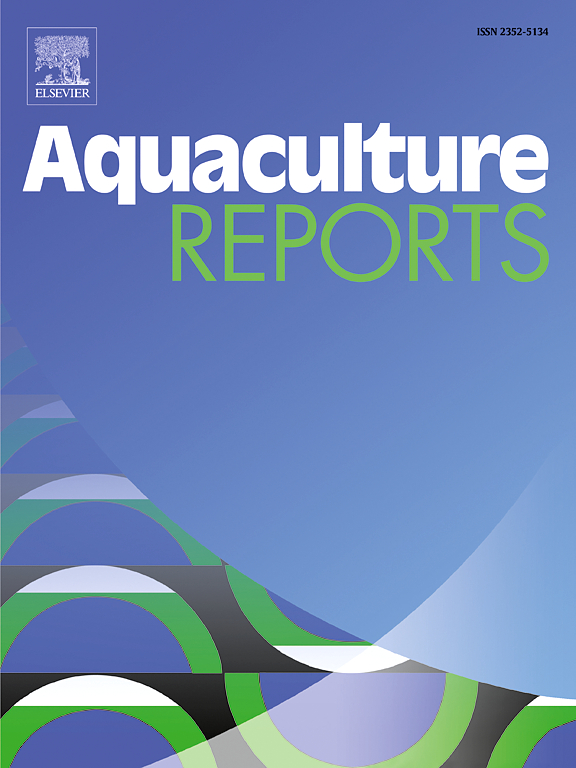Replacing fishmeal with an insect meal blend: Implications for intestinal microbiota in European seabass
IF 3.2
2区 农林科学
Q1 FISHERIES
引用次数: 0
Abstract
In this study, we investigated the effects of an insect meal (IM) blend containing larvae of Hermetia illucens and Tenebrio molitor on the gut microbiota of European seabass (Dicentrarchus labrax), a key species in Mediterranean marine aquaculture. This research stands out by examining a combination of IMs rather than a single source, thereby addressing an underexplored area in the current literature. In a feeding trial that lasted 75 days, European seabass were fed three different diets: a commercial-like control diet and two experimental diets containing partial replacement of FM with IM (25 % and 50 %). The experimental diets showed no adverse effects on feed intake or overall fish health. Analysis of the microbiota revealed significant changes in gut microbial communities, with a trend towards increased bacterial richness and diversity in fish fed IM. Beta diversity analysis showed that the mucosa-associated microbial communities were stable across diets, while the digesta-associated microbiota showed notable shifts in the IM25 and IM50 groups, suggesting that the transient microbiota is more sensitive to dietary changes. The study also found an enrichment of beneficial bacterial genera, particularly Bacillus and Paenibacillus, in fish fed IM. These genera, known for their chitinolytic activity, have likely adapted to the increased chitin content in IM diets. Oceanobacillus (Bacillaceae) and Brevibacterium (Brevibacteriaceae) were more abundant in the digesta of fish from the IM25 and IM50 groups, but not in the mucosa. Their presence indicates that they react more strongly to changes in diet than to a stable mucosal environment. Overall, the study highlights the potential of an IM-based diet to support fish health and growth while promoting a favorable gut microbiota.
用昆虫粉代替鱼粉:对欧洲鲈鱼肠道微生物群的影响
本研究研究了含有黄颡鱼(Hermetia illucens)和黄颡鱼(Tenebrio molitor)幼虫的昆虫粉(IM)混合物对地中海海洋养殖关键物种欧洲鲈鱼(Dicentrarchus labrax)肠道微生物群的影响。本研究通过检查IMs的组合而不是单一来源而脱颖而出,从而解决了当前文献中未被充分探索的领域。在为期75 d的饲养试验中,饲喂3种不同的饲料:一种类似商业的对照饲料和两种用IM部分替代鱼粉(25% %和50% %)的试验饲料。试验饲料对采食量和鱼类整体健康均无不良影响。微生物群分析显示,饲喂IM的鱼类肠道微生物群落发生了显著变化,细菌丰富度和多样性呈增加趋势。β多样性分析显示,在不同的饮食中,粘膜相关微生物群落是稳定的,而在IM25和IM50组中,消化道相关微生物群发生了显著变化,表明瞬时微生物群对饮食变化更为敏感。该研究还发现,在饲喂IM的鱼类中,有益菌属,特别是芽孢杆菌和类芽孢杆菌的富集。这些属以其几丁质溶解活性而闻名,可能已经适应了IM饮食中几丁质含量的增加。IM25和IM50组鱼类食糜中海洋杆菌和短杆菌数量较多,而粘膜中数量较少。它们的存在表明它们对饮食变化的反应比对稳定的粘膜环境的反应更强烈。总的来说,该研究强调了以im为基础的饮食在促进有利的肠道微生物群的同时支持鱼类健康和生长的潜力。
本文章由计算机程序翻译,如有差异,请以英文原文为准。
求助全文
约1分钟内获得全文
求助全文
来源期刊

Aquaculture Reports
Agricultural and Biological Sciences-Animal Science and Zoology
CiteScore
5.90
自引率
8.10%
发文量
469
审稿时长
77 days
期刊介绍:
Aquaculture Reports will publish original research papers and reviews documenting outstanding science with a regional context and focus, answering the need for high quality information on novel species, systems and regions in emerging areas of aquaculture research and development, such as integrated multi-trophic aquaculture, urban aquaculture, ornamental, unfed aquaculture, offshore aquaculture and others. Papers having industry research as priority and encompassing product development research or current industry practice are encouraged.
 求助内容:
求助内容: 应助结果提醒方式:
应助结果提醒方式:


